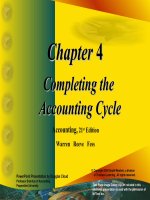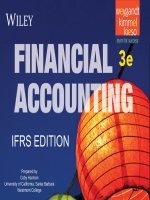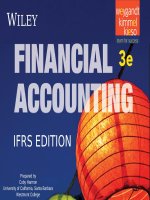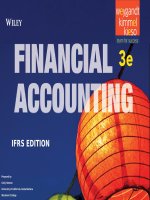Financial accounting 3e IFRS edtion willey chapter 04
Bạn đang xem bản rút gọn của tài liệu. Xem và tải ngay bản đầy đủ của tài liệu tại đây (5.1 MB, 66 trang )
WILEY
IFRS EDITION
Prepared by
Coby Harmon
University of California, Santa Barbara
4-1
Westmont College
PREVIEW OF CHAPTER 4
Financial Accounting
IFRS 3rd Edition
Weygandt ● Kimmel ● Kieso
4-2
CHAPTER
4
Completing the Accounting Cycle
LEARNING OBJECTIVES
After studying this chapter, you should be able to:
4-3
1.
Prepare a worksheet.
2.
Explain the process of closing the books.
3.
Describe the content and purpose of a post-closing trial balance.
4.
State the required steps in the accounting cycle.
5.
Explain the approaches to preparing correcting entries.
6.
Identify the sections of a classified statement of financial position.
Using a Worksheet
Learning Objective 1
Worksheet
Prepare a worksheet.
Multiple-column form used in preparing
financial statements.
4-4
Not a permanent accounting record.
May be a computerized worksheet using an electronic spreadsheet program such as Excel.
Prepared using a five step process.
Use of worksheet is optional.
LO 1
Steps in Preparing a Worksheet
Illustration 4-1
Form and procedure
for a worksheet
4-5
Steps in Preparing a Worksheet
Illustration 4-2
1. PREPARE A TRIAL BALANCE ON THE WORKSHEET
Trial balance amounts come directly from ledger
accounts.
Include all accounts with balances.
4-6
LO 1
Steps in Preparing a Worksheet
Illustration 3-23
General journal showing adjusting entries
Adjusting Journal
Entries
(Chapter 3)
4-7
Steps in Preparing a Worksheet
Illustration 4-2
2. ENTER THE ADJUSTMENTS IN THE ADJUSTMENTS COLUMNS
(a)
(b)
(d)
(d)
(e)
(g)
(a)
Adjustments Key:
(a)
Supplies Used.
(b)
Insurance Expired.
(c)
Depreciation Expensed.
(d)
Service Revenue Recognized.
(e)
Service Revenue Accrued.
(f)
Interest Accrued.
(g)
Salaries Accrued.
(b)
(c)
(c)
(e)
Enter adjustment amounts, total adjustments columns,
(f)
(f)
and check for equality.
(g)
Add additional accounts as needed.
4-8
LO 1
Steps in Preparing a Worksheet
Illustration 4-2
3. COMPLETE THE ADJUSTED TRIAL BALANCE COLUMNS
(a)
(b)
(d)
(d)
(e)
(g)
(a)
(b)
(c)
(c)
(e)
(f)
(f)
(g)
Total the adjusted trial balance columns and check for equality.
4-9
LO 1
Steps in Preparing a Worksheet
Illustration 4-2
4. EXTEND AMOUNTS TO FINANCIAL STATEMENT COLUMNS
(a)
(b)
(d)
(d)
(e)
(g)
(a)
(b)
(c)
(c)
(e)
(f)
(f)
(g)
Extend all revenue and expense account balances to the income statement
4-10
columns.
LO 1
Steps in Preparing a Worksheet
Illustration 4-2
5. TOTAL COLUMNS, COMPUTE NET INCOME (LOSS)
(a)
(b)
(d)
(d)
(e)
(g)
(a)
(b)
(c)
(c)
(e)
(f)
(f)
(g)
Compute Net Income or Net Loss.
4-11
LO 1
Steps in Preparing a Worksheet
Question
Which of the following statements is incorrect concerning the worksheet?
a.
The worksheet is essentially a working tool of the accountant.
b.
The worksheet is distributed to management and other interested parties.
c.
The worksheet cannot be used as a basis for posting to ledger accounts.
d.
Financial statements can be prepared directly from the worksheet before journalizing and posting the
adjusting entries.
4-12
LO 1
Preparing Financial Statements from a Worksheet
Income statement is prepared from the income statement columns.
Statement of financial position and retained earnings statement are prepared from the statement of
financial position columns.
4-13
Companies can prepare financial statements before they journalize and post adjusting entries.
LO 1
Preparing Statements from a Worksheet
Illustration 4-3
Financial statements from a worksheet
4-14
LO 1
Preparing Statements from a Worksheet
Illustration 4-3
Financial statements from a worksheet
4-15
LO 1
4-16
Illustration 4-3
Financial statements from a worksheet
LO 1
Preparing Adjusting Entries from a Worksheet
Adjusting entries are prepared from the adjustments columns of the worksheet.
Journalizing and posting of adjusting entries follows the preparation of financial statements when a
worksheet is used.
4-17
LO 1
DO IT!
>
Susan Elbe is preparing a worksheet. Explain to Susan how she should extend the following adjusted trial balance
accounts to the financial statement columns of the worksheet.
Cash
Statement of financial position (debit column)
Accumulated
Depreciation
Statement of financial position (credit column)
Accounts Payable
Dividends
Service Revenue
Salaries and Wages Expense
Income statement
(debit column)
Income statement
(credit column)
4-18
LO 1
Closing the Books
Learning Objective 2
At the end of the accounting period, the company makes the accounts ready for
Explain the process of closing the
books.
the next period.
Illustration 4-4
Temporary versus permanent accounts
4-19
LO 2
Preparing Closing Entries
Closing entries formally recognize in the ledger the transfer of
net income (or net loss) and
Dividends
to Retained Earnings.
Companies generally journalize and post closing entries only at the end of the annual accounting period.
Closing entries produce a zero balance in each temporary account.
4-20
LO 2
Illustration 4-5
Diagram of closing process—corporation
• HELPFUL HINT
The Dividends account is
closed directly to Retained
Earnings and not to
Income Summary because
dividends are not an
Retained earnings is a permanent
account. All other accounts are
temporary accounts.
expense.
4-21
LO 2
Illustration 4-6
4-22
Closing entries journalized
LO 2
Posting
Closing
Entries
Illustration 4-7
Posting of closing entries
4-23
LO 2
ACCOUNTING ACROSS THE ORGANIZATION
Performing the Virtual Close
Technology has dramatically shortened the closing process. Recent surveys have reported that the average company now takes
only six to seven days to close, rather than 20 days. But a few companies do much better. Some companies can perform a
“virtual close”—closing within 24 hours on any day in the quarter. One company even improved its closing time by 85%. Not very
long ago, it took 14 to 16 days. Managers at these companies emphasize that this increased speed has not reduced the
accuracy and completeness of the data. This is not just showing off. Knowing exactly where you are financially all of the time
allows the company to respond faster than competitors. It also means that the hundreds of people who used to spend 10 to 20
days a quarter tracking transactions can now be more usefully employed on things such as mining data for business intelligence
to find new business opportunities.
Source: “Reporting Practices: Few Do It All,” Financial Executive (November 2003), p. 11.
4-24
LO 2
>
DO IT!
The worksheet for Hancock Company shows the following in the financial statement columns:
Dividends
€15,000
Common stock
€42,000
Net income
€18,000
Prepare the closing entries at December 31 that affect equity.
Income Summary
18,000
Retained Earnings
Retained Earnings
Dividends
4-25
18,000
15,000
15,000
LO 2









